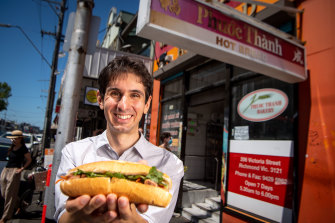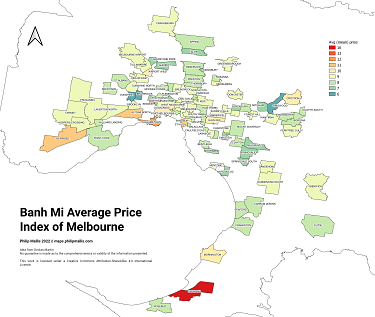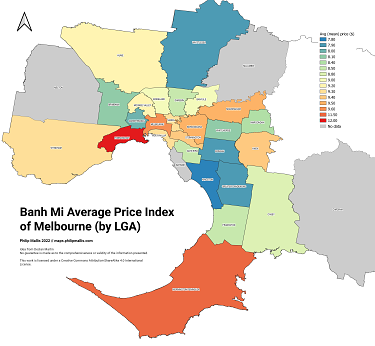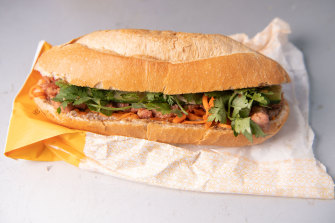It’s a lunchtime favourite consisting of a crusty white baguette filled with meat, pate, coriander, spring onion, cucumber, carrot and chilli. Usually it’s pretty cheap – so how much should a banh mi cost?
As inflation rises, for some the price of a Vietnamese pork roll remains one of the more closely watched indicators of the cost of living. A price rise of just 50 cents is cause for alarm among penny pinchers.
However one Vietnamese chef thinks we’re not paying enough for a banh mi: “It’s not valued enough,” said Jerry Mai, owner and chef of the Pho Nom and Bia Hoi restaurants.
Philip Mallis with a banh mi roll at the Phuoc Thanh bakery in Richmond.Credit:Eddie Jim
“We’ve paid the same price at some bakeries for years, how does that cover the cost of making them?”
To get a better understanding of how much a banh mi costs across Melbourne, eastern suburbs resident and pork roll enthusiast Philip Mallis has tracked the data on a map he calls the “banh mi price index”.
He compiled the information from more than 200 establishments for his suburb-by-suburb guide, finding the average price across Melbourne is $9.05.
Credit:Philip Mallis
According to the data, the cheapest suburbs are Sunshine, Braybrook and Ringwood with an average price of $6. The most expensive included Dromana ($16), Williamstown ($12) and St Kilda ($11).
Unsurprisingly, some of the most affordable areas include the banh mi belts of Footscray and Springvale ($7), well-known for being the best places to get Vietnamese food in Melbourne.
Not all banh mi are created equal. The fillings can vary from cold cuts, to roast pork belly crackling, to Chinese-style char siu barbecue pork.
Mr Mallis said he tried to standardise the prices by looking for any menu item listing “crispy pork” or “roast pork”.
Credit:Philip Mallis
“It’s one that I’ve seen at pretty much every banh mi shop I’ve ever been to and thought that’s going to be a good benchmark,” he said.
The price index does run into issues in suburbs that are relative banh mi deserts because the average cost is dictated by one or two data points.
“If you look at Hobsons Bay, for example, that one comes up as the most expensive council area. But that has, I think, only three or four shops and there are one or two that are on the higher end of the price spectrum,” he said.
Chef Jerry Mai.Credit:
It’s not the best location for banh mi cheapskates but the easiest place to find a roast pork roll is Melbourne’s CBD.
Mr Mallis said there were about 70 shops selling banh mi in the inner city, however he is adding more establishments to the map from all over the city as people share their locals.
While useful for those looking for a cheap lunch, the map could also be seen as a way of tracking gentrification in Melbourne. A banh mi is $1 more expensive in Northcote compared to Preston, for example.
Chef Jerry Mai said that the average price of a banh mi was far lower than it should be, considering what you get for the money.
“When you walk into a sandwich shop and buy a roast beef roll it’s a $12 to $13 affair and I don’t bat an eyelid,” she said. “Anything more than $6 to $7 for a banh mi, people seem to think that’s the price point – perhaps 10 years ago.”
Comparing the prices of a Melbourne bakery to a street cart in Saigon was not a useful comparison, Ms Mai said, because of the difference in the cost of ingredients, rent and wages.
The classic banh mi pork roll from Phuoc Thanh bakery in Richmond.Credit:Eddie Jim
She also said the Australian version was often overfilled: “the number one feature is the roll, the crispy crust, the fluffy interior”.
As for the fancier types of banh mi popping up on menus across the city, it’s important to remember the dish’s simple roots.
“A banh mi is a workers’ food that we grab, we eat and we go,” she said.
“It’s not about filling it to the max and putting caviar in there. We’ve just got a bit carried away.”
The Morning Edition newsletter is our guide to the day’s most important and interesting stories, analysis and insights. Sign up here.
Most Viewed in National
From our partners
Source: Read Full Article












